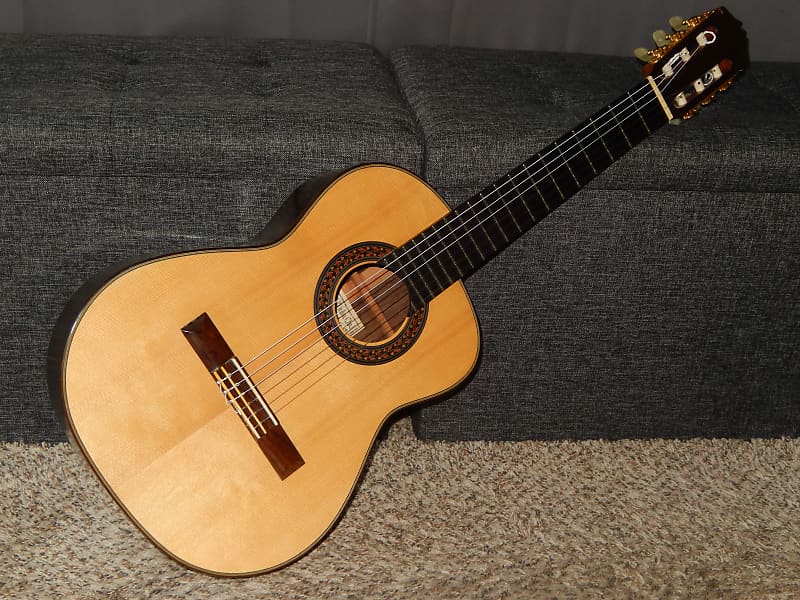

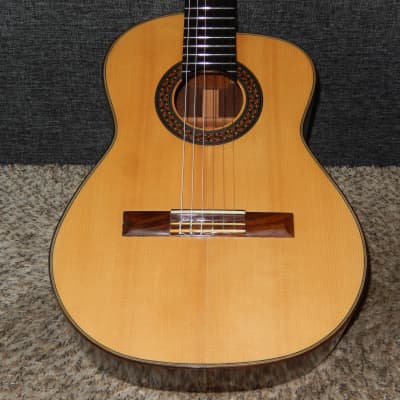
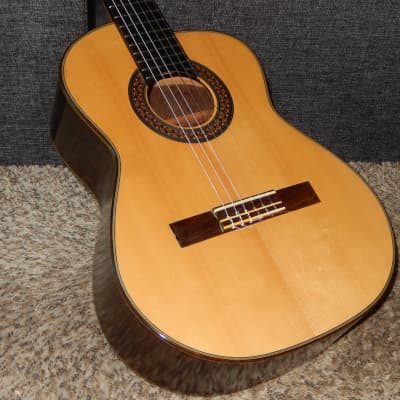
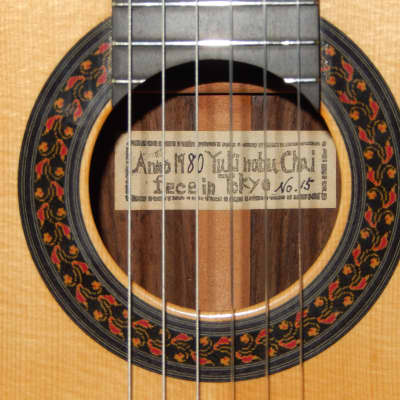
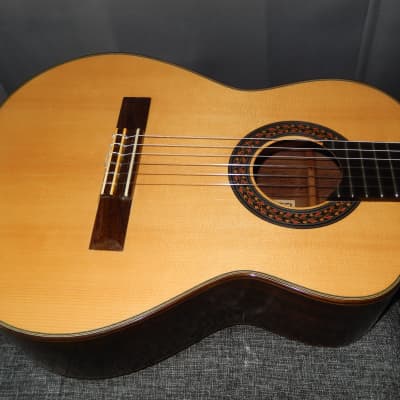
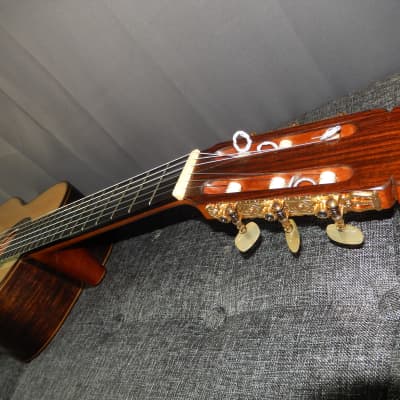
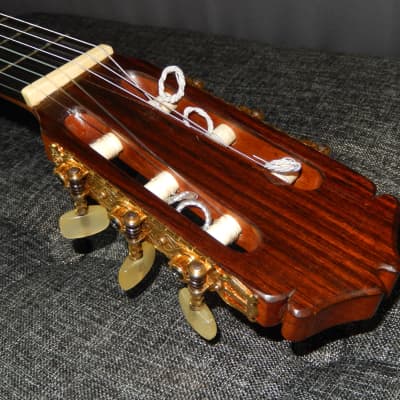
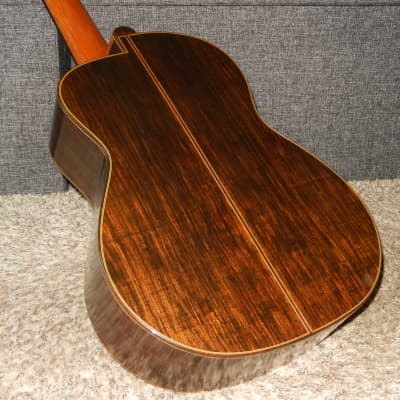
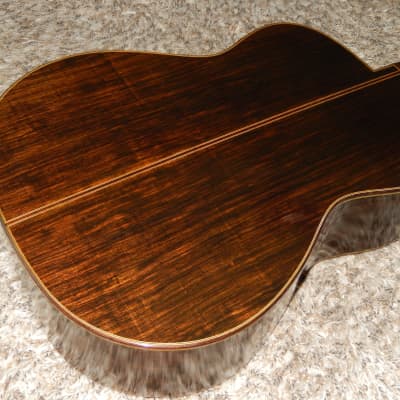
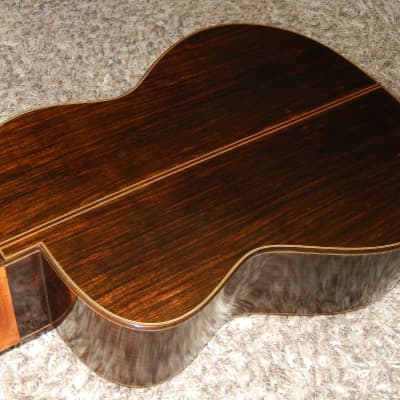
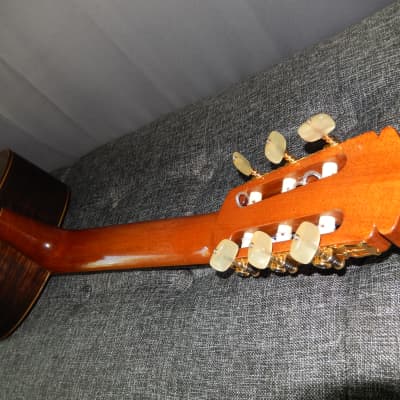
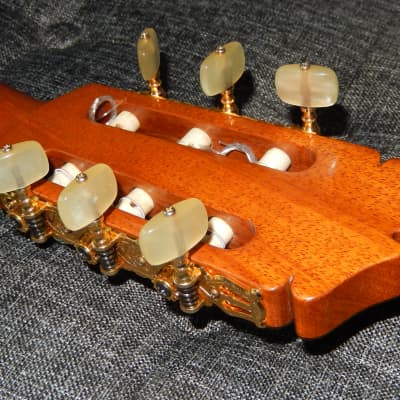
Several hundred guitars I have sold in the past are presented at Facebook.com/Victors.Guitar.Library.
Yukinobu Chai Classical Alto Concert Guitar No15 1980
This guitar was made in 1980 by Master Luthier Yukinobu Chai.
Yukinobu’s career started in late 1960s and over the years he became one of the highest respected luthiers in Japan. Most likely the major reason for that were very moderate prices for his wonderful instruments.
In that respect Yukinobu had business philosophy very similar to that represented by Ryoji Matsuoka, Kazuo Yairi or brothers Hiroshi and Mitsuru Tamura.
In early 1980s Yukinobu became the major supplier for Niibori School of Guitar Ensemble, making not only whole range of prime (regular) models but also many alto, soprano, bass and contrabass guitars. Since Yukinobu's passing in 2011, his workshop is managed by his son Yukihiro, a great luthier on his own. Yukinobu's most famous pupils are Ichizo Kobayashi, Tatsuro Kobayashi, Sakae Ishi and Kuniyoshi Matsui.
Introduction from Chai Guitar Craft facebook page:
Thank you for visiting our WEB site.
My father, Yukinobu Chai, started the guitar crafting about 55 years ago at Tamagawa Gakuen, Tokyo Japan. He was interested in making the violin when he was a student. Since then, he added many strings instruments. In 1960's, it was very popular for Japanese to play the classic guitar. This was influenced by famous movie "Jeux interdits"
My father never get a lesson from other violin builder. He just learned all from book and real violins. For Guitars, Of course, he never made it before. He has transferred some constructions from Piano. It made Chai Guitar sound & tone. He was always trying to reach his aimed tone "Sound that spread richly".
I always look at his works beside him. Naturally I started to help him. Well, it was about 20 years ago. He passed away several years ago. Now, I'm doing his work and trying to establish the Chai Guitar Brand worldwide.
Chai Guitar Craft
Yukihiro Chai President
To my ears, Yukinobu Chai was one of the best Japanese luthiers ever and remains my favorite Japanese luthier since I encountered his guitars made in 1970s. I am totally not bothered by discolorations of finishes on his guitars from that era. After selling several of his guitars I know that truly experienced guitarists looking for a “truly special” instrument are not bothered by these cosmetic imperfections either. I deeply understand why Hiroki Niibori has decided to offer Yukinobu such lucrative contract.
Even though it is not an “all solid woods” construction, it certainly is more than concert level instrument. More accurate description would be “a royal class masterpiece”. Being priced 150 000 yen in 1980 it was one of highest-end alto models made by Japanese luthiers of that era.
It was priced the same as many high-end “all solid woods” full size classical guitars (i.e., Kohno 15, Yamaha GC15) or even top of the line guitars (R. Matsuoka 150, MH150 or MR150 or K. Yairi YC150).
This guitar produces truly wonderful notes, very clear, glassy, yet very colorful trebles, somewhat metallic basses, all very well separated, and all with very impressive sustain. Despite its smaller (alto) body guitar, its volume is quite impressive too.
If you wanted to purchase the same class brand new guitar made by leading Japanese luthier, you would have to pay no less than $4500.
Similar Spanish made guitars are priced much higher.
While body of this guitar is practically free of any dents and scratches, it doesn’t have any structural problems and its overall condition can be described as "excellent for its age". The only “abnormality is that front of the headstock appears repainted by an amateur hand (perhaps to mask few minor scratches).
What was made on purpose by the maker is that headstock is connected with the neck at slight angle, with treble side lower than bass side. This trick leads to increased pressure of the treble strings over the nut, hence better response and clarity of high notes.
Very importantly its straight neck, fingerboard and frets all remain in excellent condition.
When contemporary Japanese luthiers are using 40+ years old soundboards to make “all solid woods” guitar it is priced at least $5000USD. Guitars with artificially aged (“baked”) soundboards are priced at least $4500USD. Solid top models with 40+ years old soundboards are priced at least $3500USD. American, Australian and European luthiers usually charge 50% more.
It is a matter of basic education (not beliefs) to realize that 50+ years old soundboard of this guitar alone is worth $2500USD.
Specifications:
Total length: 870mm
Body length: 420 mm
Body depth: 97-100 mm
Upper bout width: 240 mm
Lower bout width: 320 mm
Waist width: 205 mm
Top: High Grade Solid Spruce/lacquer
Back & Sides: Non-Solid Indian Rosewood/lacquer
Neck: Mahogany
Fingerboard: Ebony
Scale: 530 mm
Nut width: 50 mm
String spacing at the nut: 40 mm
String spacing at the bridge: 53 mm
Its current action is set to 3.50 mm under E6 and 3.00 mm under E1, with some extra room on the saddle.
Guitar is currently strung with D'Addario EJ52 ProArte Alto Strings designed for alto (B-B) tuning. If you'd like to play it with regular (E-E) tuning, you need regular classical guitar strings. Alto strings are of much lower gauge than regular strings, hence would feel too soft in regular (E-E) tuning. You must not try alto tuning with regular strings because that could lead to ripping off the bridge of the guitar.
This guitar will be shipped in lightly used gig-bag that matches guitar’s dimensions.
Guitar ensemble and guitar orchestra music has been developed and promoted by Hiroki Nibori since 1957 and is gaining popularity among guitar players throughout the world. Playing in a group is great fun. It is an excellent opportunity to make new friends and learn from the more advanced players. One of the most valuable aspects of playing in a guitar ensemble is that it gives students the exposure of playing on a stage in front of an audience. When you combine the sounds of alto, bass, and contra bass guitars with standard (prime) guitars, a whole new world of sound comes alive. Even the beginner will find it easy to pick up any of these guitars and enjoy a variety of new and exciting musical styles.
An ALTO GUITAR is usually tuned a 5th higher than a standard (prime) guitar. Its open tuning notes sound the same as a standard guitar played on the 7th fret position: B,E,A,D,F#,B.
BASS GUITAR is tuned 4th lower than standard guitar, one octave lower than Alto guitar: B,E,A,D,F#,B
CONTRA BASS GUITAR is tuned one octave lower than standard guitar: E,A,D,G,B,E
Real Value of Japanese Vintage Guitars
The key to understand value of vintage Japanese guitars is to acknowledge galloping price inflation (devaluation of Japanese yen) during 1960s & 1970s. This inflation slowed down in 1980s.
During 1960s and most of 1970s model numbers of Japanese guitars were strictly interconnected with their prices in Japanese yen. By early 1980s and during following decades model numbers were no longer strictly associated with their prices. Some Japanese guitar makers introduced model names instead of model numbers. Others were still using model numbers with addition of letters and/or other symbols.
It is then important to understand that two Yamaha GC10 guitars made 10 years apart are two instruments of totally different class. The same applies to any other Japanese maker/brand.
The logical way to estimate the true class of any given Japanese made instrument is to compare its price with the average annual salary of wage workers in Japanese private sectors. This salary was: 450 600 yen in 1965 - 825 900 yen in 1970 - 1 868 300 yen in 1975 - 2 689 000 yen in 1980 - 3 163 000 yen in 1985 - 3 761 000 yen in 1990 - 4 107 000 yen in 1995 - 4 082 000 yen in 2000.
Any guitar priced 100 000 yen in 1970 (labelled as No10 or No100) would be priced 200 000 yen in 1975 (relabeled to No20, No200 or 2000), 300 000 yen in 1977 (labelled as No3, No30 or 3000) and 500 000 yen by 1985 (labelled as No50 or 5000).
Starting in 1977 Masaru Kohno introduced his new models No40 priced 400 000 yen and No50 priced 500 000 yen. By early 1980s Kohno started using model names instead of numbers and was steadily raising their prices without changing model labeling. His very top model 50 became model “Special”, and a decade later it became model “Maestro”. Naturally, all other Japanese guitar makers were doing similar pricing (labelling) upgrades.
Knowing all of that, you can bet on that Masaru Kohno No50 made in 1982 is practically the same grade instrument as Kohno No20 made in 1972, or Kohno no 30 made in 1975.
In early 1970s the lowest Ryoji Matsuoka (all plywood) model was 10, followed by (solid top) models 15, 20, 25, 30, 40, 50, 60, 80 and (all solid woods) models 100 and 150. Models 50, 60 and 80 were made with non-solid figured Brazilian Rosewood (double) back and sides and top model 150 was the only one made with solid figured Brazilian Rosewood b/s.
In 1980 the lowest Matsuoka model was (all plywood) 20, followed by (solid top) models 30,40,50, 60 and all solid woods models 80,100,150 and 200. By 1990 the lowest Matsuoka model was M40 and the highest was M300. By 2010 the lowest Matsuoka model was M50 and the top model was M270.
You can bet that Ryoji Matsuoka model 50 from 1980 is of the same grade as model M100 from 2000, model 100 from 1980 is of the same grade as model M150 from 2000, model 150 from 1980 is of the same grade as M200 from 2000 and model 200 from 1980 is of the same grade as model M300 from 2000.
It is important to mention that if modern era luthiers are using 40+ years old woods to make an “all solid” wood classical guitar, its price is minimum $8000.
All vintage guitars made with Brazilian Rosewood are especially precious, including those made straight grain varieties and those with non-solid b/s.
Because response and tonal properties of Spruce soundboards are improving over time, long seasoned Spruces are far more precious than long seasoned Cedars.
It is not very difficult to find out what are current prices of such guitars made by world’s leading luthiers.
Reverb Buyer Protection
Reverb has your back if your item is lost, damaged, or doesn't match its description. Simply report any issues within 7 days and we'll help you get a full refund.Learn more about Reverb Buyer Protection.
| Listed | 2 years ago |
| Condition | Excellent (Used) Excellent items are almost entirely free from blemishes and other visual defects and have been played or used with the utmost care.Learn more |
| Brand | |
| Model |
|
| Finish |
|
| Categories | |
| Year |
|
| Made In |
|
| Body Shape |
|
